The ASUS ZenPad S (Z580CA) Review
by Brandon Chester on August 31, 2015 8:00 AM ESTGPU Performance
Rather than using Intel’s HD series iGPUs, the Atom Z3530 and Z3580 SoCs in both versions of the ZenPad S use Imagination Technologies’ PowerVR G6430 GPU. Since this implementation is identical to the one in the ZenFone 2 it’s not likely we’ll see a large gap in absolute performance. However, the larger chassis of the ZenPad may allow it to dissipate heat more effectively, which could help performance in long-term sustained workloads. It’s also worth noting that the less expensive Atom Z3530 model of the ZenPad S will suffer from reduced performance in GPU heavy workloads due to the 1GHz reduction in max CPU clock compared to the $299 model, as well as the drop in GPU speed from 533MHz to 457MHz.
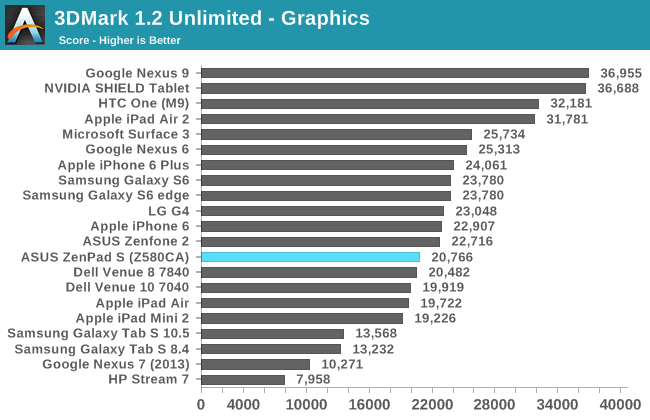
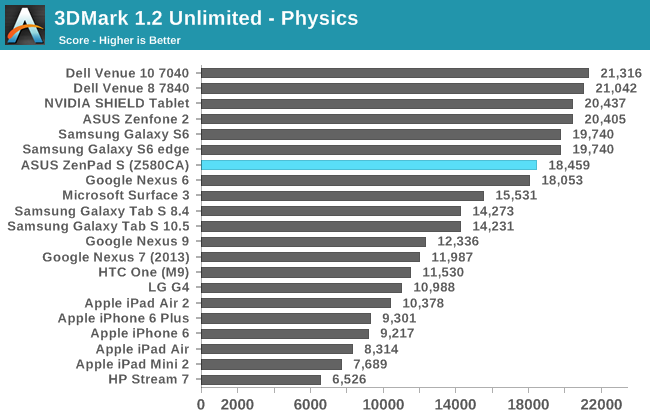
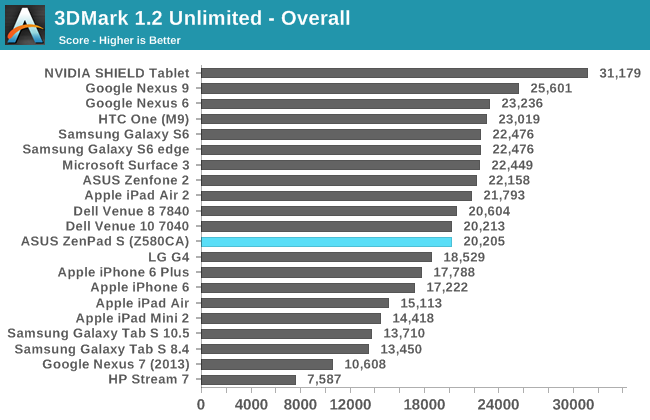
In 3DMark we actually see a noticeable gap between the ZenPad S and the ZenFone 2. The latter ends up scoring around 2000 points higher in both sub-tests, which leads to an overall score which is also around 2000 points higher. I would mostly attribute this to software differences rather than any issues with throttling, and the next tests will help to confirm that assumption.
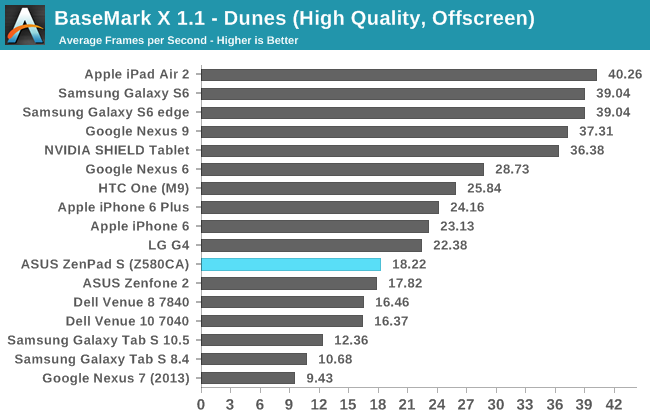
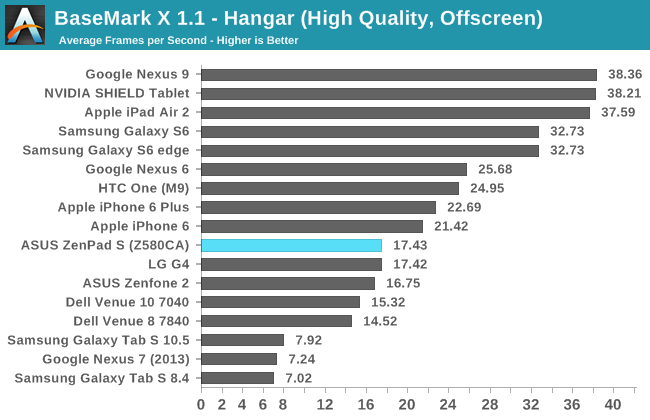

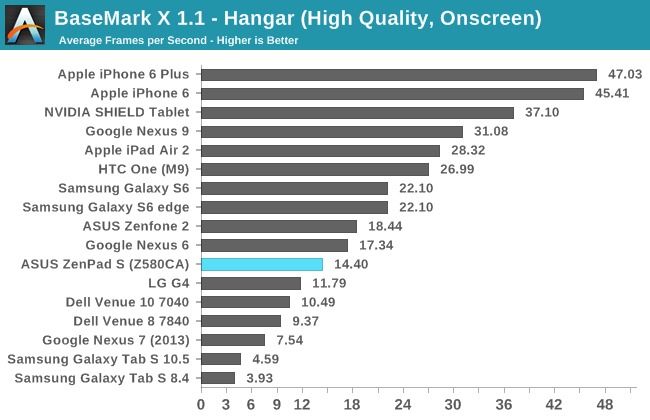
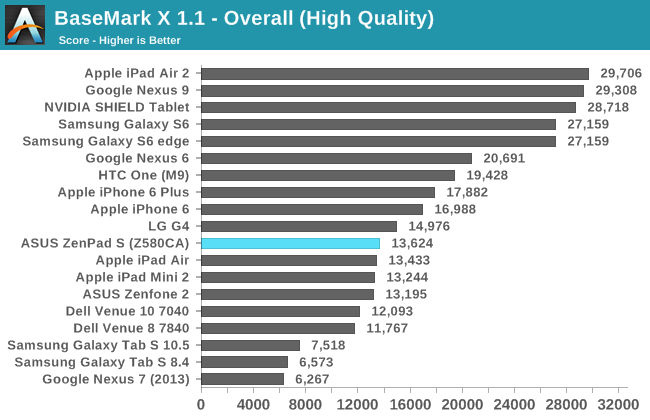
The ZenPad S doesn’t perform as well as the ZenFone 2 in BaseMark X’s on screen tests, which isn’t surprising given that it’s pushing 1.6 million more pixels. In the off screen tests we see both devices perform roughly equally, and this is reflected in the overall score. In other reviews, such as my review of the Dell Venue 8 and Venue 10 I mentioned that G6430 is a bit slow compared to the competition at that price point. For a $299 it fits perfectly, and coincidentally a lower clocked version of it is what’s used in the iPad Mini 2 which is also $299.
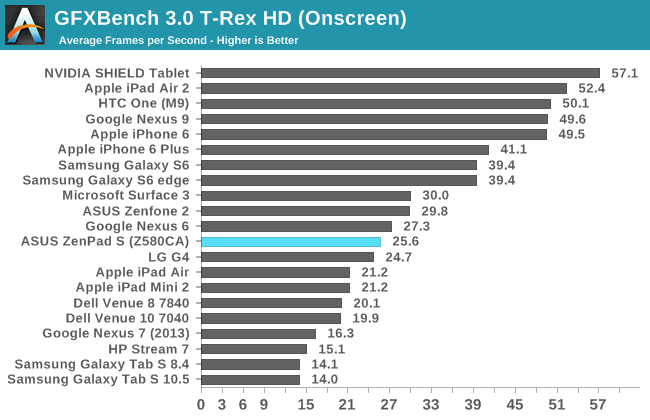
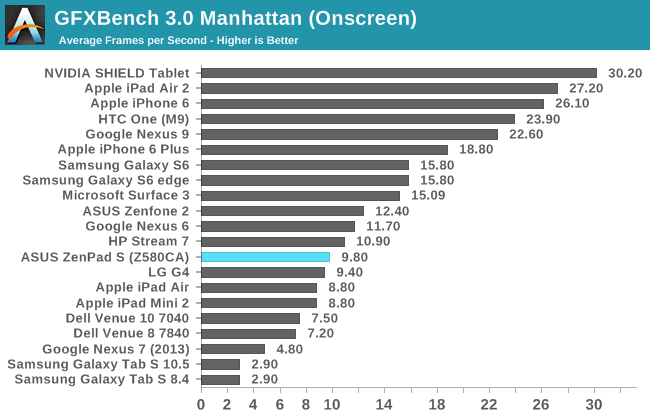
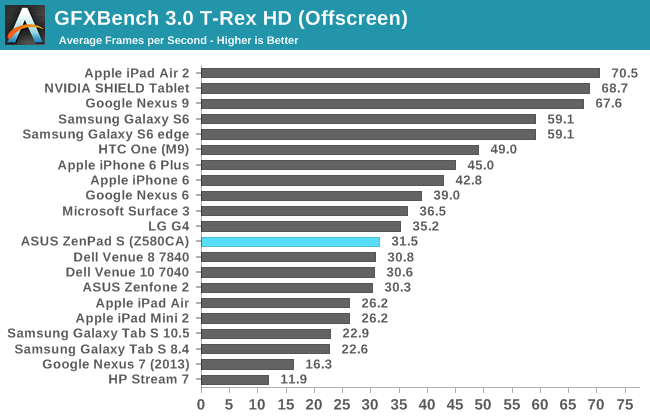

In GFXBench we again see the ZenPad S performs worse than the ZenFone 2 at its native resolution, but the overall GPU power of the two devices is equal. Like the Venue 8 and Venue 10, the PowerVR G6430 implementation in Atom Z3580 outperforms Apple’s A7 by a significant degree in the T-Rex HD test, but not in any other.
It’s clear from our tests that the GPU performance of the ZenPad S Z580CA is roughly the same as Apple’s iPad Mini 2. Since both devices have the same price, the ZenPad S is right where it needs to be in this regard. Performance in programs running at a device’s native resolution will obviously be slower than the ZenFone 2 due to the ZenPad S’s higher resolution, but I think G6430 provides more than adequate performance to run the display, and is the best you’ll be able to find in a $299 device right now.
NAND Performance
The performance of a mobile device's internal storage can have a significant impact on performance. When any applications are performing reads or writes in the background, a low NAND solution can cause the tasks the user is currently performing to grind to a halt. On top of that, there are fairly obvious implications for the time it takes to move music, movies, pictures, and other media to and from the device.
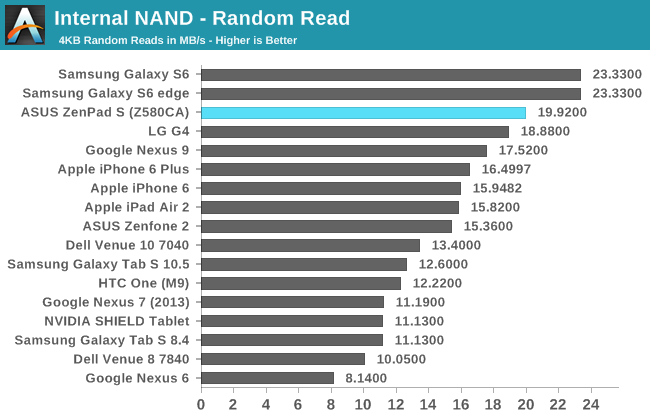
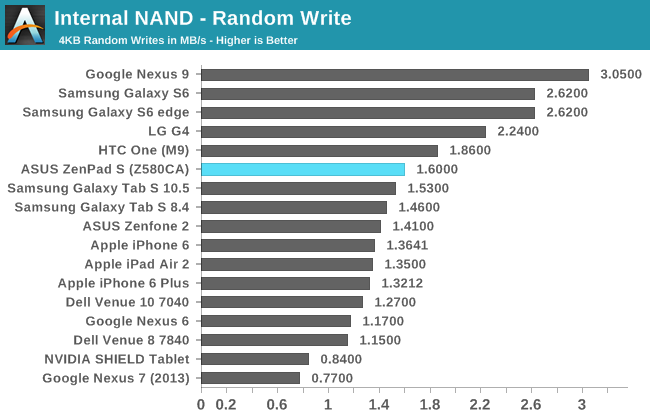
Both random read and random write speeds on the ZenPad S are very good for a mobile device. In both cases it ends up being the fastest tablet on record.
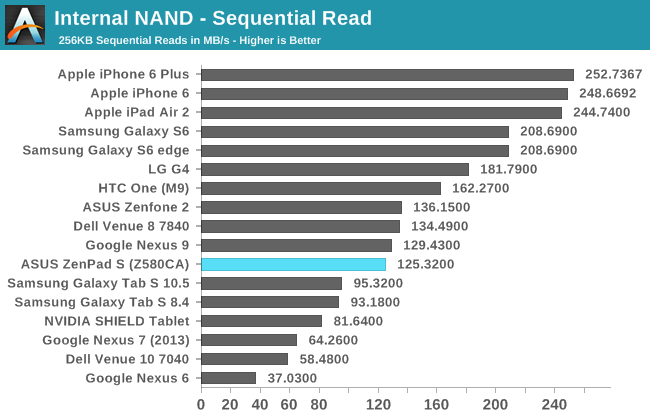
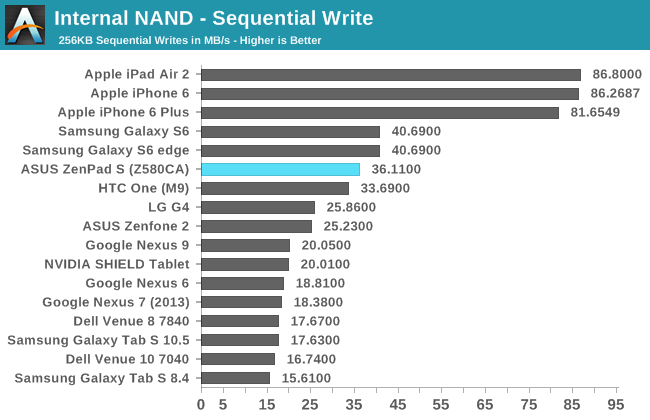
The sequential read speed on the ZenPad S is good for a $299 device, and the sequential write speed is actually the fastest we've seen in an Android tablet. However, it's disappointing to see that Android devices can now adopt USB 3.0 without terrible connectors by using USB Type-C, yet they still have NAND that won't even saturate a USB 2.0 link in the best possible scenario. Relative to the NAND in other Android devices the ZenPad S performs well, but the speed of eMMC flash memory still leaves much to be desired.










114 Comments
View All Comments
DanNeely - Monday, August 31, 2015 - link
The "sharpening" filter that smudges text legibility is the deal breaker. Having tried using them before, I completely agree with the reviewer about how badly they suck. They might help in some circumstances; but having the opposite effect on one thing that needs legibility more than anything else makes them worse than useless as an always on feature.I still don't get what you're going on about the Samsung and $100 more. AGAIN, I don't find it too expensive compared to the Zenpad. If the Samsung didn't have retarded buttons it looks like it'd be a great device and I'd probably own one. Putting the same level of hardware in a chassis with buttons in the correct order shouldn't drive the price to $500.
MrSavage - Monday, August 31, 2015 - link
You think the Z580CA would have blurred or smudged text? I tell you this. I'm going into a store and seeing to believe. It's late 2015 and if you're telling me that a new tablet with new technology is going to have some blurry or unclear text or visuals? If this was 2012 I might buy that.Regarding Samsung and $100? Have you actually gone spec by spec to compare? Beyond that, if you put 2GB of RAM (Samsung with around 3) and the same 32GB of storage? I would bet this Z580CA would be selling for $250 or less! No front speakers, no stylus support on top of that. I think your idea of reasonable or wise differs from mine.
So you are taking a few charts on the display as being the final word? If there are any issues regarding software enhancements, I'm confident in firmware and software updates to resolve any possible issue. I have some faith in that and considering the price, it's not exactly a super risky proposition.
PixyMisa - Monday, August 31, 2015 - link
On specs, the $399 S2 is closer to the $199 Z580C. I expect the AMOLED screen will be very nice, though.A side-by-side comparison of the 8" iPad, S2, and Z580C/CA would be very interesting.
Kepe - Monday, August 31, 2015 - link
How about an HP Pro Slate 8? The only real downside seems to be the bundled pen contraption, but you don't have to use it, of course.DanNeely - Monday, August 31, 2015 - link
First I've seen it; but other than potential availability (HP doesn't have it in immediate stock, and Amazon appears to only have the Win8 model), I don't see any show stoppers in a quick look at reviews. Paying for a pen'd just end up in my junk drawer's annoying but if it's my only option...modulusshift - Monday, August 31, 2015 - link
Since I have an Air 2 running the latest iOS 9 beta, I decided to see what you meant by performance enhancements.Kraken 1.1 - 2446.3
Octane v2 - 10441
WebXPRT 2015 -
modulusshift - Monday, August 31, 2015 - link
162 was the WebXPRT score. So yeah, some improvements have definitely been made. The Air 2 now out scores every tablet score you have on that table by a significant margin.Brandon Chester - Monday, August 31, 2015 - link
Yeah that's what I meant. I will be able to update the iPad Air 2 once iOS 9 releases, but I don't have an Air or a Mini 2/3 on hand.modulusshift - Monday, August 31, 2015 - link
For fun, a MacBook Pro 13 on Yosemite:Kraken - 2013.6
Octane - 21636
WebXPRT 2015 - 320
Kepe - Monday, August 31, 2015 - link
In short: you get what you pay for. Display you have to calibrate yourself with software that makes it horrible, mediocre performance, mediocre build quality with low-quality materials, horrible camera, non-competitive battery life. But hey, at least you get front-facing stereo speakers that are ok!